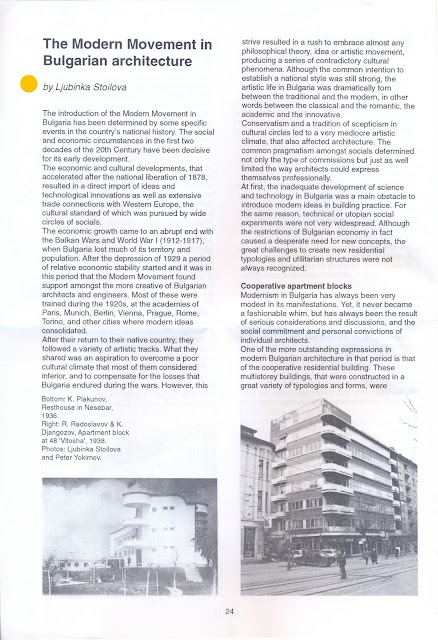Декларация, публикувана при учредяването на
ДОКОМОМО България - българската секция към международната организация за документация и консервация на паметници и забележителни места на Модерното движение - ДОКОМОМО Интернешънъл, 1994 г.Declaration, published in 1994 with the founding of DOCOMOMO Bulgaria - the Bulgarian working party to the international organisation for DOcumentation and COnservation of buildings, sites and monuments of the MOdern MOvement - DOCOMOMO International.
публикувана в сп. Архитектура, 2 (1994)
Изминалите 60 години от времето, когато идеите на Модерното движение се въплъщаваха на дело, са достатъчно дълъг период тези идеи да бъдат многократно реинтерпретирани, отхвърляни и преосмисляни. Днес в исторически ракурс се подлагат на преоценка ролята и значението на Модерното движение и се изтъква преди всичко неговото огромно влияние върху архитектурното творчеството през втората половина на ХХ век. Историческата дистанция е достатъчна, за да се възприемат творческите постижения на интернационалния стил не само като материална среда, но и като културна ценност - летопис на времето и памет, която да бъде изучавана и грижовно пазена от посегателства и разрушения. Не трябва да се забравя и социалният принос на Модерното движение: породен от социална идеология, стремежът на творците бе чрез своето архитектурно творчество да допринесат за демократизация на обществото и за разширяване на човешкото благополучие. Днес именно този дух на модернизма, съчетан с неизменния стремеж към новаторство и утвърждаване ролята на архитекта в обществения живот, е все още актуален.
За популяризирането на този съществен принос в редица страни на Европа се развива движение за документиране и опазване паметниците на Модерното движение DOCOMOMO под егидата на ICOMOS към UNESCO.
В края на двадесетте и през тридесетте години плеяда български архитекти с ентусиазъм прилагаха усвоеното във висшите училища на Западна Европа. Те пренесоха и вляха в България тенденциите на Модерното движение съобразно идеите и принципите на Ог. Пере, Льо Корбюзие, Ад. Лоос, В. Гропиус, Х. Майер, Мис ван дер Рое, Бр. Таут, Ер. Менделсон и редица други. Ст. Белковски, Ив. Данчов, Г. Овчаров, Йор. Йорданов, С. Овчаров, Ив. Васильов, Д. Цолов, Тр. Трендафилов, Т. Горанов, Т. Златев, Д. Коев, Р. Радославов, К. Джангозов, Н. Ямантиев, Ас. Михайловски, Ан. Дамянов и много други вложиха не само професионални умения за създаването на една нова - модернистична - естетика, но и амбицията да допринесат за просперитета на хората в България чрез по-добра организация на градовете и по-хигиенични условия на обитаване, труд и отдих.
Днес обликът на цели квартали с жилищни кооперации, на важни обществени и производствени сгради в големите градове все още носи белезите на създаденото от българските модернисти. Запазили са своя чар и множество индивидуални къщи, спотаени сред агресивните урбанистични структури или усамотени в природата. За съжаление много сгради са вече само спомен, други се рушат под неумолимия натиск на времето, трети са загубили своята идентичност. Съзнателното заклеймяване на модернизма като изява на декадентски настроения през 1950-те години също допринесе за неговото неглижиране през последните четири десетилетия. В настоящия период на бързи промени и размах на строителната инициатива, редица по-малки обекти са застрашени от физическо или художествено унищожение поради тяхното недооценяване или комерсиализиране.
Ето защо ние сме убедени, че проявленията на Модерното движение в България се нуждаят от популяризация, за да се направят обществено достояние както личностите на редица изтъкнати български архитекти, така и художествената стойност на техните творби. За да бъдат те оценени наравно с постиженията в другите области на българската художествена култура от същия период и да бъдат ситуирани в общоевропейския културен процес. Убедени сме, че тези архитектурни паметници се нуждаят от системно документиране и защита, за да се запази за идните поколения дирята на едно по-ново време от развитието на българската култура.
В името на тази достойна цел поставяме основите на национална секция на ДОКОМОМО, която ще работи за престижа на Модерното движение в България заедно с колегите от останалите страни на Европа.
арх. Пеньо Столаров, арх. Петър Йокимов (1935-2014),
арх. Христо Анастасов (1913-2009), арх. Любинка Стоилова,
арх. Георги Георгиев, арх. Анна Добринова,
арх. Добрина Желева Мартинс-Виана
Co-founding members are the architects, as follows:
Penyo Stolarov, Petar Iokimov (1935-2014),
Christo Anastassov (1913-2009), Ljubinka Stoilova,
Georgi Georgiev, Anna Dobrinova,
Dobrina Zheleva Martins-Viana
Превод на части от декларацията, публикувани в списанието
на международната организация през 1995 г.Co-founding members are the architects, as follows:
Penyo Stolarov, Petar Iokimov (1935-2014),
Christo Anastassov (1913-2009), Ljubinka Stoilova,
Georgi Georgiev, Anna Dobrinova,
Dobrina Zheleva Martins-Viana
Превод на части от декларацията, публикувани в списанието
Parts of the declaration translated into English were published
in the journal of the international organisation in 1995.

През 2001-2003 г. членове-учредители на ДОКОМОМО България бяха инициатори за спасяването на къщата на Д. Яблански в София (китайско посолство в периода 1948-1993).
Членове-учредители на българската секция съставиха първите предложения за включване на български обекти в международния регистър на ДОКОМОМО Интернешънъл (1998-2004); съставиха и внесоха петицията за спасяване на Гранд-хотел "България" (2007, http://sofiazanas.blogspot.bg/2007/11/blog-post.html),
и петицията за опазване къщата на арх. Георги Фингов на ул. "Шипка" 38 (2009, http://sofiazanas.blogspot.bg/2009/11/et-38.html), всички в София.
С тяхно участие се изписаха множество становища и публикации за обекти на архитектурата и градоустройството на Модерното движение в България.
In 2001-2003 founding members of DOCOMOMO Bulgaria initiated the rescue of Villa D. Yablanski in Sofia (Embassy of China in the period 1948-1993).
Founding members of the Bulgarian WP compiled the first proposals for including of Bulgarian Modern Movement sites in the international register of DOCOMOMO (1998-2004). They compiled and registered the petition for rescuе of Bulgaria Grand Hotel (2007, http://sofiazanas.blogspot.bg/2007/11/citizens-petition.html),
as well as the petition for rescue of the house of architect Georgi Fingov in 38 Shipka St. (2009, http://sofiazanas.blogspot.bg/2009/11/petition-for-saving-of-villa-of.html), all in Sofia.
Many expert statements and publications on objects of the Modern Movement architecture and city planning were prepared with their participation.
https://www.academia.edu/31076910/Архитектурната_среда_на_ХХ_век_Architectural_Environment_Of_The_20th_Century











